Chloride dependence of hyperpolarization-activated chloride channel gates
- PMID: 10050002
- PMCID: PMC2269146
- DOI: 10.1111/j.1469-7793.1999.341ac.x
Chloride dependence of hyperpolarization-activated chloride channel gates
Abstract
1. ClC proteins are a class of voltage-dependent Cl- channels with several members mutated in human diseases. The prototype ClC-0 Torpedo channel is a dimeric protein; each subunit forms a pore that can gate independently from the other one. A common slower gating mechanism acts on both pores simultaneously; slow gating activates ClC-0 at hyperpolarized voltages. The ClC-2 Cl- channel is also activated by hyperpolarization, as are some ClC-1 mutants (e.g. D136G) and wild-type (WT) ClC-1 at certain pH values. 2. We studied the dependence on internal Cl- ([Cl-]i) of the hyperpolarization-activated gates of several ClC channels (WT ClC-0, ClC-0 mutant P522G, ClC-1 mutant D136G and an N-terminal deletion mutant of ClC-2), by patch clamping channels expressed in Xenopus oocytes. 3. With all these channels, reducing [Cl-]i shifted activation to more negative voltages and reduced the maximal activation at most negative voltages. 4. We also investigated the external halide dependence of WT ClC-2 using two-electrode voltage-clamp recording. Reducing external Cl- ([Cl-]o) activated ClC-2 currents. Replacing [Cl-]o by the less permeant Br- reduced channel activity and accelerated deactivation. 5. Gating of the ClC-2 mutant K566Q in normal [Cl-]o resembled that of WT ClC-2 in low [Cl-]o, i.e. channels had a considerable open probability (Po) at resting membrane potential. Substituting external Cl- by Br- or I- led to a decrease in Po. 6. The [Cl-]i dependence of the hyperpolarization-activated gates of various ClC channels suggests a similar gating mechanism, and raises the possibility that the gating charge for the hyperpolarization-activated gate is provided by Cl-. 7. The external halide dependence of hyperpolarization-activated gating of ClC-2 suggests that it is mediated or modulated by anions as in other ClC channels. In contrast to the depolarization-activated fast gates of ClC-0 and ClC-1, the absence of Cl- favours channel opening. Lysine 556 may be important for the relevant binding site.
Figures
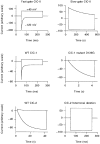
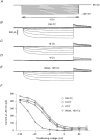
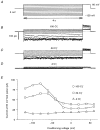
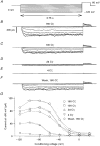
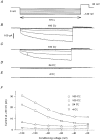
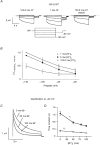
 . Both time constants decrease with increasing concentrations of bromide.
. Both time constants decrease with increasing concentrations of bromide.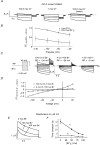
Similar articles
-
Concentration and pH dependence of skeletal muscle chloride channel ClC-1.J Physiol. 1996 Dec 1;497 ( Pt 2)(Pt 2):423-35. doi: 10.1113/jphysiol.1996.sp021778. J Physiol. 1996. PMID: 8961185 Free PMC article.
-
Inward rectification in ClC-0 chloride channels caused by mutations in several protein regions.J Gen Physiol. 1997 Aug;110(2):165-71. doi: 10.1085/jgp.110.2.165. J Gen Physiol. 1997. PMID: 9236209 Free PMC article.
-
Electrostatic control and chloride regulation of the fast gating of ClC-0 chloride channels.J Gen Physiol. 2003 Nov;122(5):641-51. doi: 10.1085/jgp.200308846. J Gen Physiol. 2003. PMID: 14581587 Free PMC article.
-
Coupling gating with ion permeation in ClC channels.Sci STKE. 2003 Jun 24;2003(188):pe23. doi: 10.1126/stke.2003.188.pe23. Sci STKE. 2003. PMID: 12824475 Review.
-
Structural insights into chloride and proton-mediated gating of CLC chloride channels.Biochemistry. 2004 Feb 10;43(5):1135-44. doi: 10.1021/bi0359776. Biochemistry. 2004. PMID: 14756549 Review.
Cited by
-
A tale of two CLCs: biophysical insights toward understanding ClC-5 and ClC-7 function in endosomes and lysosomes.J Physiol. 2015 Sep 15;593(18):4139-50. doi: 10.1113/JP270604. Epub 2015 Jun 26. J Physiol. 2015. PMID: 26036722 Free PMC article. Review.
-
Discovery of CLC transport proteins: cloning, structure, function and pathophysiology.J Physiol. 2015 Sep 15;593(18):4091-109. doi: 10.1113/JP270043. Epub 2015 Aug 24. J Physiol. 2015. PMID: 25590607 Free PMC article. Review.
-
A pH-sensitive chloride current in the chemoreceptor cell of rat carotid body.J Physiol. 2001 Aug 15;535(Pt 1):95-106. doi: 10.1111/j.1469-7793.2001.00095.x. J Physiol. 2001. PMID: 11507160 Free PMC article.
-
Pathogenesis of hypertension in a mouse model for human CLCN2 related hyperaldosteronism.Nat Commun. 2019 Oct 15;10(1):4678. doi: 10.1038/s41467-019-12113-9. Nat Commun. 2019. PMID: 31615979 Free PMC article.
-
Dual regulation of the native ClC-K2 chloride channel in the distal nephron by voltage and pH.J Gen Physiol. 2016 Sep;148(3):213-26. doi: 10.1085/jgp.201611623. J Gen Physiol. 2016. PMID: 27574292 Free PMC article.
References
-
- Carew MA, Thorn P. Identification of ClC-2-like chloride currents in pig pancreatic acinar cells. Pflügers Archiv. 1996;433:84–90. - PubMed
-
- Dinudom A, Young JA, Cook DI. Na+ and Cl− conductances are controlled by cytosolic Cl− concentration in the intralobular duct cells of mouse mandibular glands. Journal of Membrane Biology. 1993;135:289–295. - PubMed
Publication types
MeSH terms
Substances
Grants and funding
LinkOut - more resources
Full Text Sources

